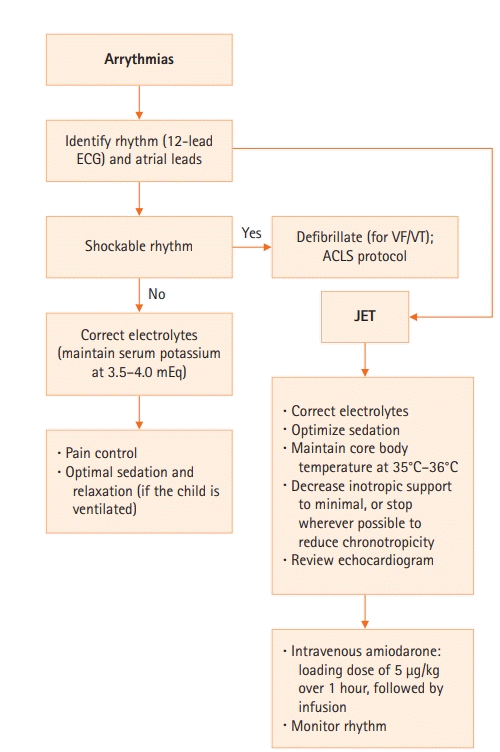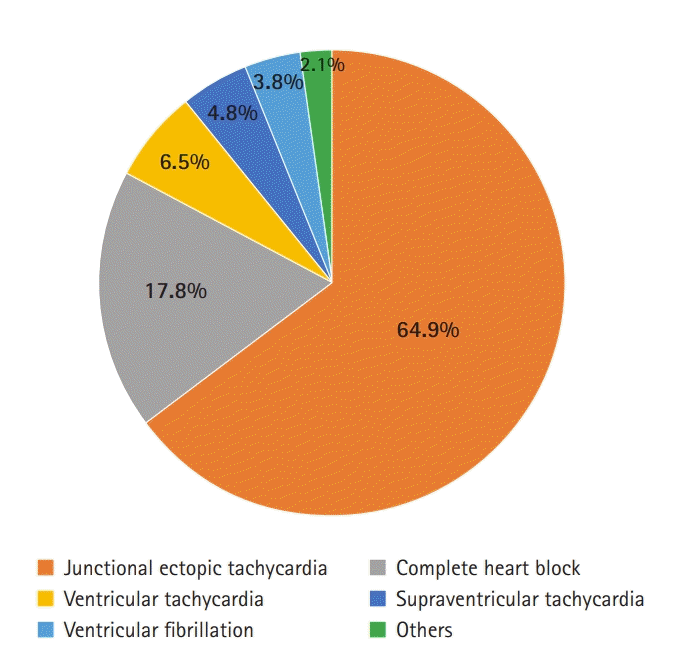1. Romer AJ, Tabbutt S, Etheridge SP, Fischbach P, Ghanayem NS, Reddy VM, et al. Atrioventricular block after congenital heart surgery: analysis from the Pediatric Cardiac Critical Care Consortium. J Thorac Cardiovasc Surg. 2019; 157:1168–77.e2.

2. Delaney JW, Moltedo JM, Dziura JD, Kopf GS, Snyder CS. Early postoperative arrhythmias after pediatric cardiac surgery. J Thorac Cardiovasc Surg. 2006; 131:1296–300.

3. Pfammatter JP, Bachmann DC, Wagner BP, Pavlovic M, Berdat P, Carrel T, et al. Early postoperative arrhythmias after open-heart procedures in children with congenital heart disease. Pediatr Crit Care Med. 2001; 2:217–22.

4. Hoffman TM, Wernovsky G, Wieand TS, Cohen MI, Jennings AC, Vetter VL, et al. The incidence of arrhythmias in a pediatric cardiac intensive care unit. Pediatr Cardiol. 2002; 23:598–604.

5. Choi HJ, Kim YH, Cho JY, Hyun MC, Lee SB, Kim KT. Early postoperative arrhythmias after open heart surgery of pediatric congenital heart disease. Korean J Pediatr. 2010; 53:532–7.

6. Yildirim SV, Tokel K, Saygili B, Varan B. The incidence and risk factors of arrhythmias in the early period after cardiac surgery in pediatric patients. Turk J Pediatr. 2008; 50:549–53.
7. Kabbani MS, Al Taweel H, Kabbani N, Al Ghamdi S. Critical arrhythmia in postoperative cardiac children: recognition and management. Avicenna J Med. 2017; 7:88–95.

8. Sahu MK, Das A, Siddharth B, Talwar S, Singh SP, Abraham A, et al. Arrhythmias in children in early postoperative period after cardiac surgery. World J Pediatr Congenit Heart Surg. 2018; 9:38–46.

9. Anselmi A, Abbate A, Girola F, Nasso G, Biondi-Zoccai GG, Possati G, et al. Myocardial ischemia, stunning, inflammation, and apoptosis during cardiac surgery: a review of evidence. Eur J Cardiothorac Surg. 2004; 25:304–11.

10. Cools E, Missant C. Junctional ectopic tachycardia after congenital heart surgery. Acta Anaesthesiol Belg. 2014; 65:1–8.
11. Talwar S, Patel K, Juneja R, Choudhary SK, Airan B. Early postoperative arrhythmias after pediatric cardiac surgery. Asian Cardiovasc Thorac Ann. 2015; 23:795–801.

12. Jain A, Alam S, Viralam SK, Sharique T, Kapoor S. Incidence, risk factors, and outcome of cardiac arrhythmia postcardiac surgery in children. Heart Views. 2019; 20:47–52.

13. Jenkins KJ, Gauvreau K, Newburger JW, Spray TL, Moller JH, Iezzoni LI. Consensus-based method for risk adjustment for surgery for congenital heart disease. J Thorac Cardiovasc Surg. 2002; 123:110–8.

14. de Caen AR, Berg MD, Chameides L, Gooden CK, Hickey RW, Scott HF, et al. Part 12: pediatric advanced life support: 2015 American Heart Association Guidelines update for cardiopulmonary resuscitation and emergency cardiovascular care. Circulation. 2015; 132(18 Suppl 2):S526–42.
15. Lan YT, Lee JC, Wetzel G. Postoperative arrhythmia. Curr Opin Cardiol. 2003; 18:73–8.

16. Hoffman TM, Bush DM, Wernovsky G, Cohen MI, Wieand TS, Gaynor JW, et al. Postoperative junctional ectopic tachycardia in children: incidence, risk factors, and treatment. Ann Thorac Surg. 2002; 74:1607–11.

17. Hoque KZ, Sultana AT, Mia M, Chowdhury MG, Hossein M. Early postoperative arrhythmias after paediatric cardiac surgery. Delta Med Coll J. 2018; 6:22–8.

18. Brown KL, Ridout DA, Goldman AP, Hoskote A, Penny DJ. Risk factors for long intensive care unit stay after cardiopulmonary bypass in children. Crit Care Med. 2003; 31:28–33.

19. Pagowska-Klimek I, Pychynska-Pokorska M, Krajewski W, Moll JJ. Predictors of long intensive care unit stay following cardiac surgery in children. Eur J Cardiothorac Surg. 2011; 40:179–84.

20. Paul T, Ziemer G, Luhmer L, Bertram H, Hecker H, Kallfelz HC. Early and late atrial dysrhythmias after modified Fontan operation. Pediatr Med Chir. 1998; 20:9–11.
21. Dodge-Khatami A, Miller OI, Anderson RH, Goldman AP, Gil-Jaurena JM, Elliott MJ, et al. Surgical substrates of postoperative junctional ectopic tachycardia in congenital heart defects. J Thorac Cardiovasc Surg. 2002; 123:624–30.

22. Abdelaziz O, Deraz S. Anticipation and management of junctional ectopic tachycardia in postoperative cardiac surgery: single center experience with high incidence. Ann Pediatr Cardiol. 2014; 7:19–24.






 PDF
PDF Citation
Citation Print
Print




 XML Download
XML Download